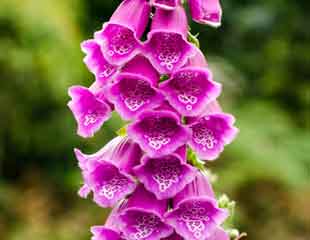


How to grow foxgloves
Foxgloves are an easy to grow, self seeding biennials which are attractive to bees.
Foxgloves are ideal for growing in semi shade. Although semi shade is their preferred growing conditions, Foxgloves are fully hardy and will grow in almost any conditions and soil except the extremes of very wet or dry. Foxgloves are tall plants, D. purpurea (the common foxglove) grows up to 1-2m.
Foxgloves look most effective grown in clumps or drifts, especially in natural or wildlife garden. D. purpurea is one of our native plants and an excellent source of nectar for bees. Our native foxglove requires a period of cold frosty weather to initiate flowering. This process is called vernalization. This characteristic is shared with many spring bulbs, daffodils crocus, hyacinths,also garlic, hollyhocks and carrots. Modern hybrids do not require this and will flower from year 1.
The common foxglove is usually pink as in the left image, or pure white or white with purple specks. New popular variations include the Excelsior Hybrids (RHS Merit) which come in a variety of pastel shades and apricot illustrated above right 'Sutton's Apricot'. (more ideas for plants which are bee and butterfly friendly)
The native foxglove flowers open down one side of the stem, usually the side which faces the sun.
Foxgloves are easy to grow
Note: Foxgloves are poisonous. Do not eat any part of the plant, and if you have children, consider avoiding planting foxgloves. If you have concerns about a plant, there is a list of poisonous plants on the RHS website.

Foxgloves are easy to grow and self seed extensively, providing you with a regular, free supply of plants. Foxgloves can be perennials, biennials and annuals but the most commonly grown varieties biennial. This means they set seed, produce the plant and foliage one year, and flower the next. Once you have Foxgloves in the garden, they will self seed so regularly as to produce a continuous set of new plants and flowers. Once established after the first year, the fact that Foxgloves are biennials isn't a problem.
Whilst Foxgloves do self seed extensively, they are not troublesome. You can easily remove unwanted seedlings, or transplant them to preferred locations.
Ideal growing conditions for Foxgloves are moist soil, humus rich, a little acid as you may expect from a Woodland plant. Foxgloves are fully hardy to between H5- H7. That said, Foxgloves are tenacious. I have seen them growing out of stone walls in the smallest trough of poor soil.
When the plant has finished flowering, it will be full of seed. In the autumn, during September & October time, you can split the seed heads easily by crushing them, and shake out the seeds where you would prefer the new plants to grow. Leave the seeds on the soil surface as they need light to germinate. If you are not fussy where the plants grow, you can leave them and the wind will distribute the seed, dropping it around and dispersing seeds widely around your garden on the autumn winds.
Foxgloves used to be regarded as a cottage plant, but have revived in popularity recently, rightly so, as they look super in a mixed border. The pure white foxgloves look lovely in a mixed border as illustrated and the bees love them. There are so many good points to growing Foxgloves, easy, no maintenance, happy in semi shade and self seed themselves, definitely a green wheelbarrow plant.
How to grow just white foxgloves

White foxgloves are popular and do look very stylish. In the image above the white foxgloves have been cross pollinated by D. purpurea so pink flowers are in with the white. If you want to create a white border, or just want to grow white digitals you can check out the seedlings to allow only the white flowering plants to grow on, and stop the bees cross pollinating in the future.
If you look at a young seedling, if the vein at the back is clear, it will grow into a white flower, any hints of pink, and you will have pink varieties. You will need to remove any seedlings which are not showing as white.
White borders look very stylish. Vita Sackville-West is often credited with creating the first white border at her garden in Sissinghurst Castle Garden. The Easton Walled Garden boasts a pretty impressive white border, illustrated below. It is famed for its sweet peas, but has so much more to see, wonderful herbaceous planting, wildflowers, wooded areas, colourful vegetable plots its so worth a visit.


I have labelled Foxgloves as Green Wheelbarrow because they are easy to grow. They require no maintenance, no staking or feeding and will self seed around the garden to re appear next year, albeit often in a different place.
RHS plant trial of Foxgloves
In 2013-2015 RHS undertook a trial of Digitalis and awarded some biennial the AGM.
D. purpurea 'Pam's Choice' which is very distinctive white with purple/dark maroon throat.
In the Camelot Series ' Camelot Cream, lovely creamy white flowers with purple spotting in the throat. An F1 hybrid which blooms from Year 1.
In the Dalmatian series, Dalmatian Creme, Peach, Purple, Rose and White'
he RHS AGM is always a good indicator when selecting a plant the trial as assessing floriferousness, length of flowering, shade tolerance, longevity, decorative value, uniformity of seed strains, pest and disease resistance and overwintering ability. From this you can be confident that the RHS variety will be a good plant to grow.
